I. Introduction

A. The importance of outdoor tool storage for efficient organization and maintenance
A well-organized outdoor space not only provides a visually appealing environment but also helps in efficient maintenance of your tools. Storing tools properly not only protects them from damage but also saves time and effort in finding the right tool when needed.
B. Creating a tidy and functional outdoor space with proper storage solutions
By choosing the right outdoor tool storage solutions, you can create a tidy and functional outdoor space. Proper storage solutions ensure that tools are easily accessible, reducing the chances of misplacement or damage. Furthermore, a well-organized outdoor space allows you to make the most of your limited space, giving you room for other activities.
II. Choosing the Right Outdoor Tool Storage Solutions
A. Assessing storage needs and available space
- Determining the types and sizes of tools to be stored Before selecting the appropriate storage options, it is essential to assess the types and sizes of tools you need to store. This will help you determine the size and capacity requirements for the storage solutions.
- Evaluating available outdoor space for storage options Consider the available outdoor space for placing the storage units. Some spaces may require freestanding storage solutions, while others may be more suitable for wall-mounted options. Understanding your available space will help you make an informed decision.
B. Outdoor Storage Options for Tools

- Tool sheds and outdoor storage cabinets a. Features and benefits of purpose-built tool sheds Tool sheds provide dedicated space for storing a variety of tools, large and small. They typically have multiple shelves, compartments, and even workbenches. Purpose-built tool sheds are constructed with durable materials, ensuring longevity and protection for your tools.
Factors to consider when choosing outdoor storage cabinets Outdoor storage cabinets are an excellent option for storing smaller tools and accessories. They are often made of weather-resistant materials, providing protection against the elements. When choosing outdoor storage cabinets, consider factors such as size, durability, and accessibility.
- Storage benches and deck boxes a. Utilizing multipurpose storage benches for seating and storage Storage benches serve a dual purpose of offering seating as well as storage. They are ideal for smaller tools and accessories. By choosing storage benches, you can make the most of your outdoor seating area while keeping tools easily accessible.
Advantages of deck boxes for lightweight tool storage Deck boxes are lightweight and versatile storage solutions that can be placed on the deck, patio, or in the garden. They are perfect for storing lightweight tools and equipment, such as garden gloves, seed packets, and small hand tools. Deck boxes often feature a hinged lid, providing easy access to stored items.
- Wall-mounted solutions and pegboard systems a. Utilizing wall space to maximize storage efficiency Wall-mounted storage solutions utilize vertical space to optimize storage efficiency. They are ideal for hanging garden tools, such as shovels, rakes, and hoes. Wall-mounted options keep frequently used tools within reach while saving valuable floor space.
Customizing pegboard systems for specific tool storage needs Pegboard systems are versatile and customizable options for tool organization. With a pegboard, you can arrange hooks, shelves, and bins to suit your specific tool storage needs. This allows for easy access and quick identification of tools, resulting in a more efficient workflow.
III. Organizing and Storing Tools in Outdoor Storage Solutions

A. Categorizing tools and optimizing storage layouts
To effectively organize your tools in outdoor storage solutions, it is essential to categorize them based on type, size, or frequency of use. This will allow for efficient storage and easy retrieval when needed. Additionally, optimizing storage layouts ensures that the space is utilized effectively, maximizing storage capacity.
When categorizing tools, consider grouping similar tools together. For example, garden tools like shovels and rakes can be stored in one area, while power tools such as drills and saws can be stored in another. This allows for better organization and prevents tools from getting misplaced.
Designing storage layouts involves arranging tools in a logical and accessible manner. Frequently used tools should be positioned in easily reachable areas, while tools that are used less often can be stored in less accessible spaces. This not only ensures easy access but also maximizes the functionality of your outdoor storage solutions.
B. Using dividers, racks, and hooks for tool organization

Dividers and compartments play a crucial role in tool organization by separating different tools and preventing them from banging against each other. They also offer protection against potential damage, reducing wear and tear. Consider using tool chests or boxes with built-in dividers or invest in storage solutions that provide customizable compartments.
Racks and hooks are excellent options for hanging and displaying frequently used tools. They not only save space but also make it easier to locate and access tools quickly. Installing a pegboard system or wall-mounted racks allows for easy customization and adaptability to your changing tool collection.
C. Incorporating labeling and inventory systems for easy tracking
Labeling is an effective way to identify the contents of different storage areas or containers. Use waterproof and durable labels that clearly indicate the contents, making it easier to find specific tools. Labeling helps save time and ensures that tools are returned to their designated places after use.
Creating an inventory system enables better tracking and accountability for your tools. Assign each tool a unique number or code and create a corresponding record in your inventory system. This allows you to track when a tool is borrowed or returned, minimizing the chances of tools becoming lost or misplaced.
IV. Maintaining and Securing Outdoor Tool Storage Solutions

A. Regular maintenance and cleaning practices
Regular maintenance and cleaning are essential for outdoor tool storage solutions to ensure their longevity and functionality. Cleaning the storage units periodically prevents dirt, grime, and rust buildup, which can damage tools over time. Wipe down storage surfaces and clean shelves or compartments to remove any debris.
Inspect the storage units regularly for any signs of damage or wear and tear. Replace or repair any damaged parts promptly to prevent further deterioration. This proactive approach to maintenance ensures that your storage solutions remain in good condition and continue to protect your tools effectively.
B. Securing outdoor tool storage against theft and weather damage
Outdoor tools are vulnerable to theft, and exposure to harsh weather conditions can damage both the tools and the storage solutions. Implement security measures, such as locks, alarms, or security cameras, to deter potential thieves and protect your tools.
To safeguard storage solutions from the weather, consider investing in weather-resistant storage boxes or sheds. Ensure that storage units are properly sealed to prevent water leakage. Additionally, position storage solutions in areas with minimal exposure to direct sunlight or extreme weather conditions. Regularly inspect storage units for any signs of damage caused by weather, such as cracks or warping, and address them promptly.
By following these tips for organizing, storing, and maintaining your outdoor tools, you can create a well-organized and efficient space that enhances your outdoor activities and protects your valuable tools. Remember that a well-maintained storage system not only extends the life of your tools but also saves time and effort in locating and using them. Make the most of your outdoor tool storage solutions to ensure a clutter-free and functional outdoor space.





















